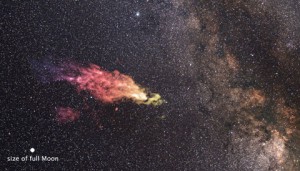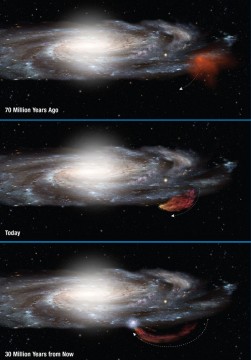The massive Smith Cloud falling toward our galaxy’s disk is likely from the Milky Way, not a visitor.

Composite: NASA / ESA / Z. Levay (STScI), Smith Cloud: B. Saxton and F. Lockman (NRAO / AUI / NSF), Sky: A. Mellinger
The Milky Way enjoys a light drizzle throughout its galactic year. These cosmic raindrops are speedy clouds of mostly hydrogen gas that rain down onto our galaxy’s spiral disk. They fly through space at hundreds of kilometers per second (millions of miles per hour) and don’t rotate with the Milky Way. They’re appropriately named high-velocity clouds.
This shower of gas is important for fueling star formation. The Milky Way assembles stars at a respectable rate of about one solar mass per year. But it takes gas to keep that starbirth going. Much as the manna from heaven fed the Israelites, these clouds feed star formation in the Milky Way by replenishing the galaxy’s gas at the same rate as the galaxy burns through it.
Despite their importance, we know a paltry amount about these star-fueling clouds. What they’re made of, where they come from, or even how far away they are — astronomers generally scratch their heads about all of these.
A major exception is the Smith Cloud. First discovered by Gail Smith in the 1960s, the Smith Cloud lies 40,000 light-years away and contains 2 million solar masses’ worth of gas, primarily hydrogen. It’s falling toward the Milky Way at nearly 300 km/s (660,000 mph). And a new study of its contents suggests that it came from the Milky Way.
Andrew Fox (Space Telescope Science Institute) and his colleagues used the Hubble Space Telescope and the 91-meter (300-foot) Green Bank Telescope to better understand what the Smith Cloud is made of. The astronomers took advantage of three distant active galactic nuclei (AGN) that lie behind the cloud from our perspective. Using Hubble, the team observed the AGN through the cloud, to see how well the gas absorbed certain wavelengths from the blazing black holes’ light. Which wavelengths the gas absorbs, and how deeply, reveals how tainted the cloud is by elements heavier than helium, elements that astronomers call metals.
The researchers focused on ionized sulfur, which is a good proxy for metal content. They found that the Smith Cloud contains about half the concentration of metals that the Sun does. This new measurement matches up with a previous (albeit imprecise) estimate based on emission from the cloud’s nitrogen atoms. Importantly, it’s also a close match for the gas in the Milky Way’s outer disk.

NASA / ESA / A. Feild (STScI)
Metals come from stars: they’re fused together inside stars or created when the stars die. But astronomers don’t know of a single star in the Smith Cloud, stresses study coauthor Jay Lockman (National Radio Astronomy Observatory). So it’s highly unlikely that the cloud is a chewed-up dwarf galaxy or a pristine, first-time visitor from intergalactic space.
Instead, the team argues in the January 1st Astrophysical Journal Letters, the gas probably comes from the Milky Way itself, specifically our galaxy’s outer disk, which — given the Smith Cloud’s orbit — the object either passed through, or came from, about 70 million years ago.
Thus, the cloud was either spewed out of or torn out of our galaxy. But the Smith Cloud is too massive to be spray from a “galactic fountain,” expelled by a cluster of supernovae in the outer disk, unless it picked up a lot more material on its journey. It might be a big clump of dark matter that zipped through the galaxy and grabbed gas as it went, but it’s unlikely to have picked up so much material.
During its swing through space, the Smith Cloud has morphed into a comet-like streamer. It’s fragmenting as it boomerangs back toward the disk, which it will ram into in about 30 million years, spurring starbirth. The team is now trying to figure out how much dark matter (if any) might be holding the cloud together, by mapping the object’s full extent and calculating whether dark matter would best explain its size and shape.
Assuming the Smith Cloud’s gas really does come from the outer disk, it looks like we know where the object came from and where it’s going — we just don’t know what it is. Guess it really is galactic manna: some scholars think “manna” means “what is it?”
Reference: Andrew J. Fox et al. “On the Metallicity and Origin of the Smith High-Velocity Cloud.” Astrophysical Journal Letters. January 1, 2016.
 0
0
Comments
You must be logged in to post a comment.